Management and Operation: Leadership, Management, and Operations
VerifiedAdded on 2020/10/05
|15
|5292
|330
Report
AI Summary
This report delves into the core aspects of management and operations, beginning with a comparison of the roles and characteristics of leaders and managers, including their differences and similarities. It then explores Henri Fayol's functions of a manager, such as planning, organizing, commanding, coordinating, monitoring, and initiating. The report also covers various leadership theories, including situational, system, and contingency leadership, providing examples to illustrate their practical application. Furthermore, it discusses different approaches to operations management, the role of a store manager, and the importance of operation management within an organization. Finally, it identifies key external factors affecting operation management and their impacts on decision-making processes. The report uses examples to illustrate the concepts discussed, making it a comprehensive overview of the subject.
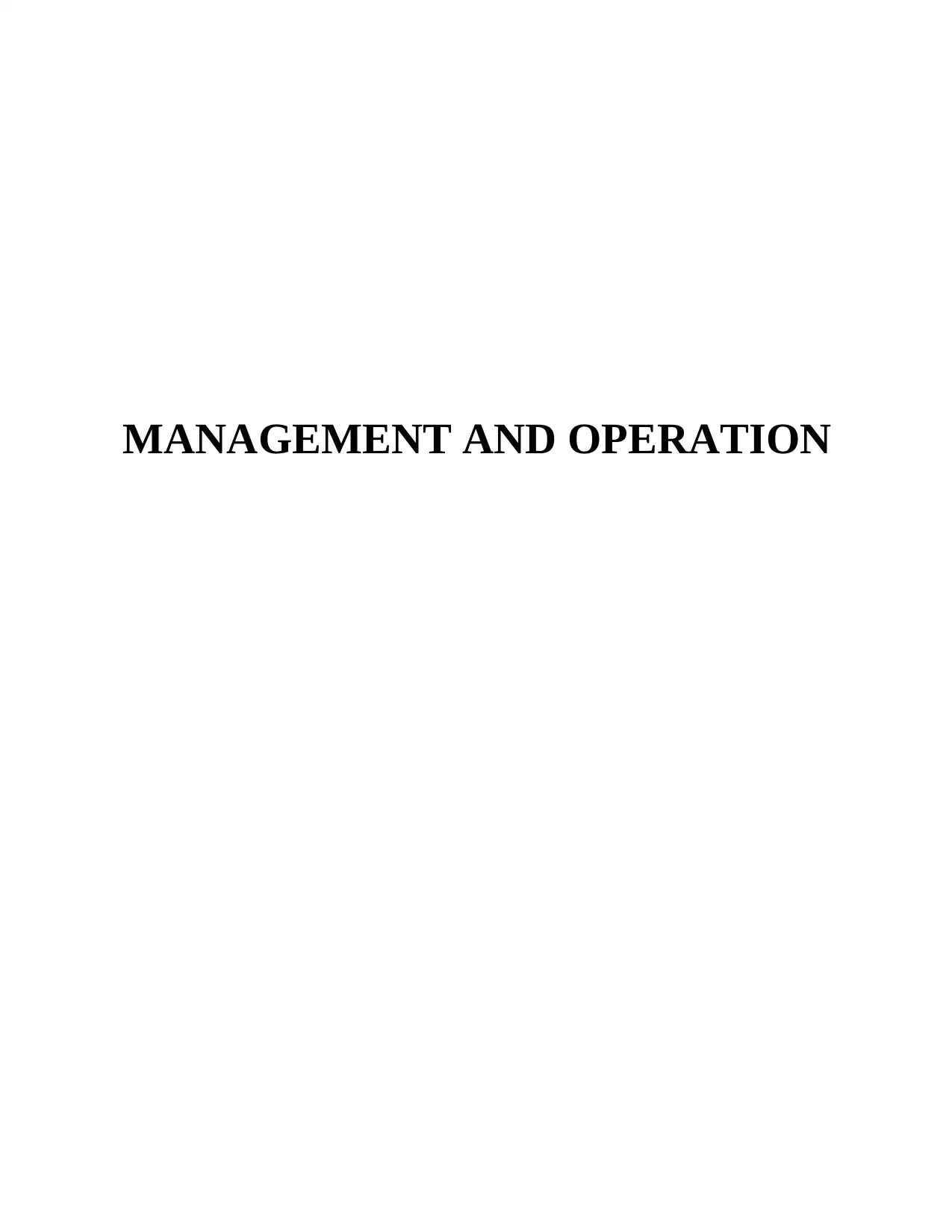
MANAGEMENT AND OPERATION
Paraphrase This Document
Need a fresh take? Get an instant paraphrase of this document with our AI Paraphraser
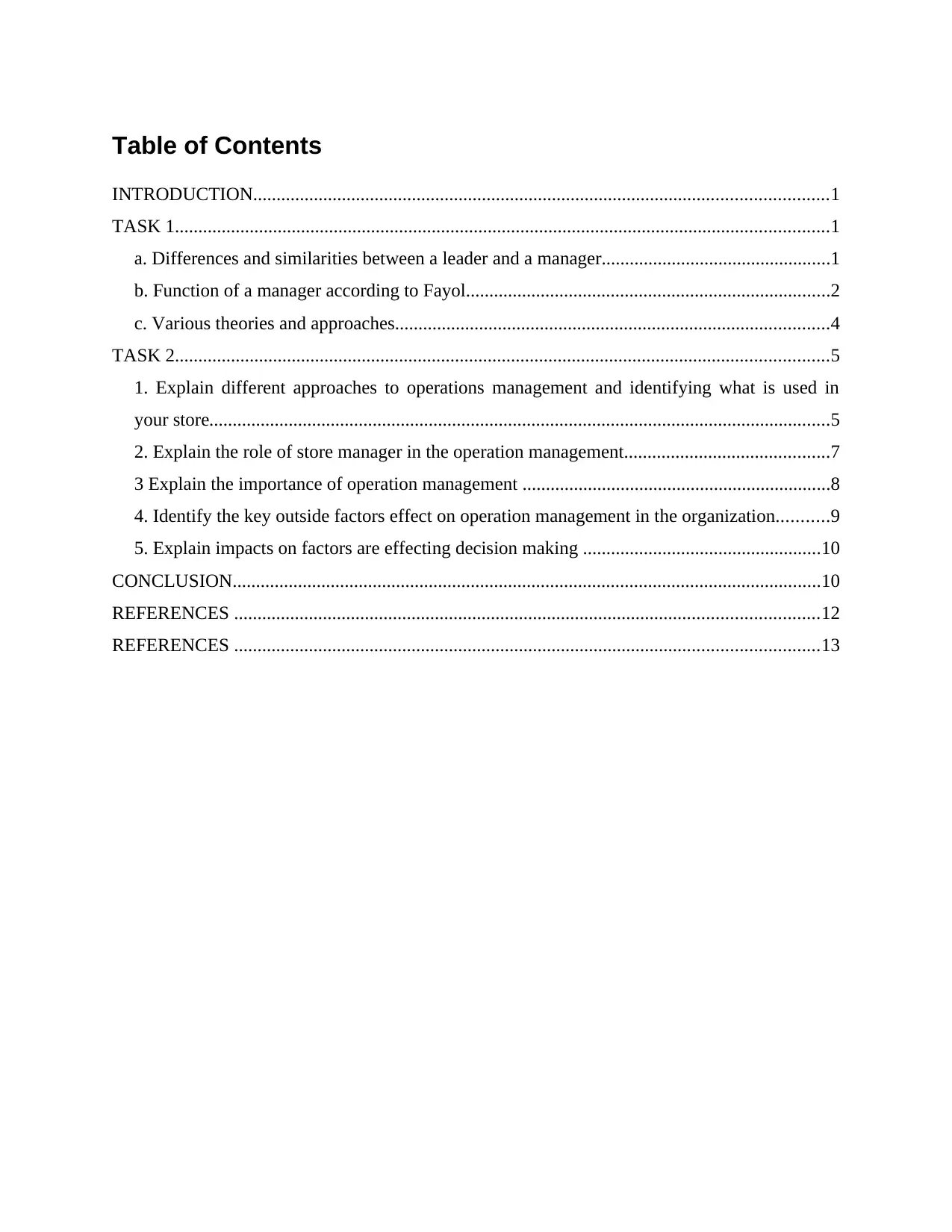
Table of Contents
INTRODUCTION...........................................................................................................................1
TASK 1............................................................................................................................................1
a. Differences and similarities between a leader and a manager.................................................1
b. Function of a manager according to Fayol..............................................................................2
c. Various theories and approaches.............................................................................................4
TASK 2............................................................................................................................................5
1. Explain different approaches to operations management and identifying what is used in
your store.....................................................................................................................................5
2. Explain the role of store manager in the operation management............................................7
3 Explain the importance of operation management ..................................................................8
4. Identify the key outside factors effect on operation management in the organization...........9
5. Explain impacts on factors are effecting decision making ...................................................10
CONCLUSION..............................................................................................................................10
REFERENCES .............................................................................................................................12
REFERENCES .............................................................................................................................13
INTRODUCTION...........................................................................................................................1
TASK 1............................................................................................................................................1
a. Differences and similarities between a leader and a manager.................................................1
b. Function of a manager according to Fayol..............................................................................2
c. Various theories and approaches.............................................................................................4
TASK 2............................................................................................................................................5
1. Explain different approaches to operations management and identifying what is used in
your store.....................................................................................................................................5
2. Explain the role of store manager in the operation management............................................7
3 Explain the importance of operation management ..................................................................8
4. Identify the key outside factors effect on operation management in the organization...........9
5. Explain impacts on factors are effecting decision making ...................................................10
CONCLUSION..............................................................................................................................10
REFERENCES .............................................................................................................................12
REFERENCES .............................................................................................................................13
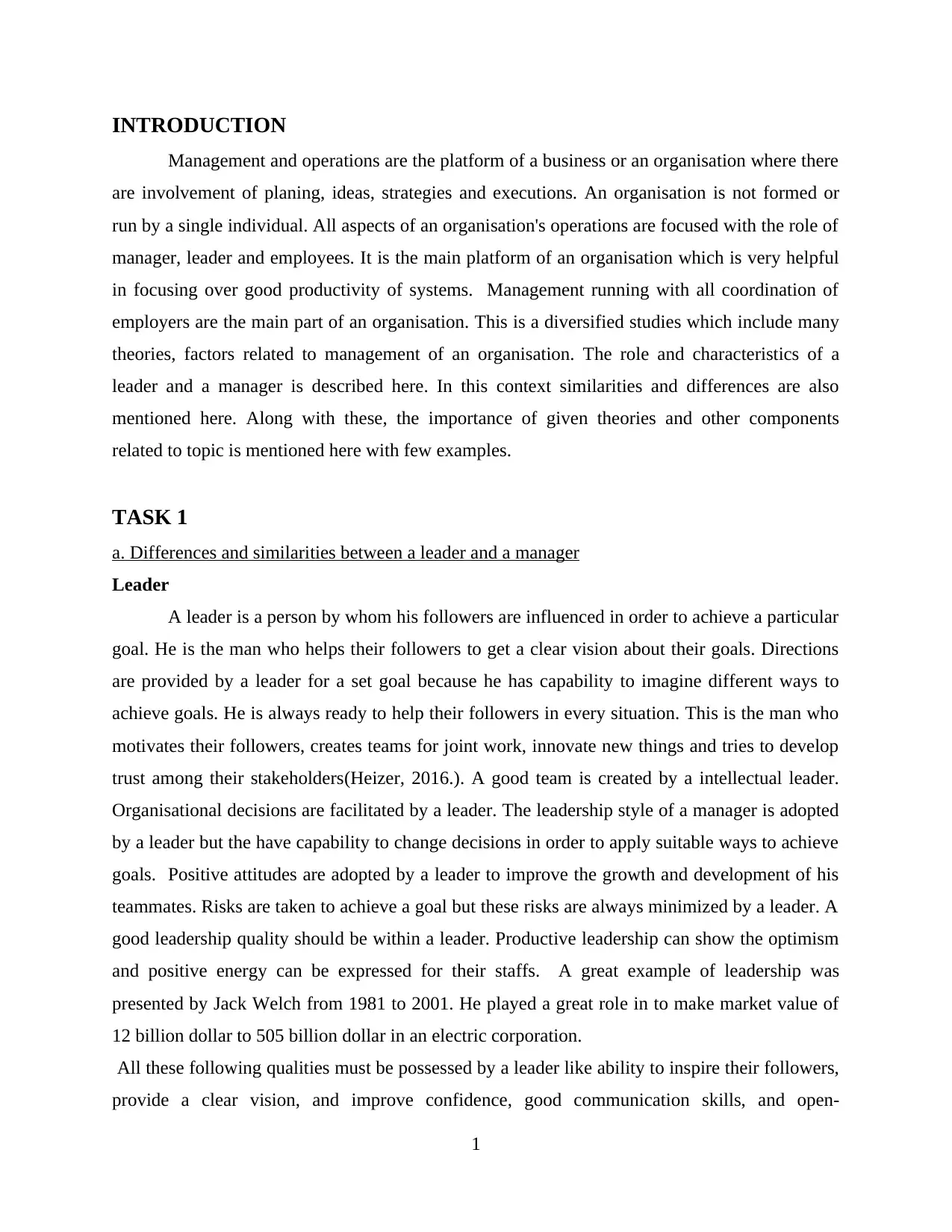
INTRODUCTION
Management and operations are the platform of a business or an organisation where there
are involvement of planing, ideas, strategies and executions. An organisation is not formed or
run by a single individual. All aspects of an organisation's operations are focused with the role of
manager, leader and employees. It is the main platform of an organisation which is very helpful
in focusing over good productivity of systems. Management running with all coordination of
employers are the main part of an organisation. This is a diversified studies which include many
theories, factors related to management of an organisation. The role and characteristics of a
leader and a manager is described here. In this context similarities and differences are also
mentioned here. Along with these, the importance of given theories and other components
related to topic is mentioned here with few examples.
TASK 1
a. Differences and similarities between a leader and a manager
Leader
A leader is a person by whom his followers are influenced in order to achieve a particular
goal. He is the man who helps their followers to get a clear vision about their goals. Directions
are provided by a leader for a set goal because he has capability to imagine different ways to
achieve goals. He is always ready to help their followers in every situation. This is the man who
motivates their followers, creates teams for joint work, innovate new things and tries to develop
trust among their stakeholders(Heizer, 2016.). A good team is created by a intellectual leader.
Organisational decisions are facilitated by a leader. The leadership style of a manager is adopted
by a leader but the have capability to change decisions in order to apply suitable ways to achieve
goals. Positive attitudes are adopted by a leader to improve the growth and development of his
teammates. Risks are taken to achieve a goal but these risks are always minimized by a leader. A
good leadership quality should be within a leader. Productive leadership can show the optimism
and positive energy can be expressed for their staffs. A great example of leadership was
presented by Jack Welch from 1981 to 2001. He played a great role in to make market value of
12 billion dollar to 505 billion dollar in an electric corporation.
All these following qualities must be possessed by a leader like ability to inspire their followers,
provide a clear vision, and improve confidence, good communication skills, and open-
1
Management and operations are the platform of a business or an organisation where there
are involvement of planing, ideas, strategies and executions. An organisation is not formed or
run by a single individual. All aspects of an organisation's operations are focused with the role of
manager, leader and employees. It is the main platform of an organisation which is very helpful
in focusing over good productivity of systems. Management running with all coordination of
employers are the main part of an organisation. This is a diversified studies which include many
theories, factors related to management of an organisation. The role and characteristics of a
leader and a manager is described here. In this context similarities and differences are also
mentioned here. Along with these, the importance of given theories and other components
related to topic is mentioned here with few examples.
TASK 1
a. Differences and similarities between a leader and a manager
Leader
A leader is a person by whom his followers are influenced in order to achieve a particular
goal. He is the man who helps their followers to get a clear vision about their goals. Directions
are provided by a leader for a set goal because he has capability to imagine different ways to
achieve goals. He is always ready to help their followers in every situation. This is the man who
motivates their followers, creates teams for joint work, innovate new things and tries to develop
trust among their stakeholders(Heizer, 2016.). A good team is created by a intellectual leader.
Organisational decisions are facilitated by a leader. The leadership style of a manager is adopted
by a leader but the have capability to change decisions in order to apply suitable ways to achieve
goals. Positive attitudes are adopted by a leader to improve the growth and development of his
teammates. Risks are taken to achieve a goal but these risks are always minimized by a leader. A
good leadership quality should be within a leader. Productive leadership can show the optimism
and positive energy can be expressed for their staffs. A great example of leadership was
presented by Jack Welch from 1981 to 2001. He played a great role in to make market value of
12 billion dollar to 505 billion dollar in an electric corporation.
All these following qualities must be possessed by a leader like ability to inspire their followers,
provide a clear vision, and improve confidence, good communication skills, and open-
1
⊘ This is a preview!⊘
Do you want full access?
Subscribe today to unlock all pages.

Trusted by 1+ million students worldwide
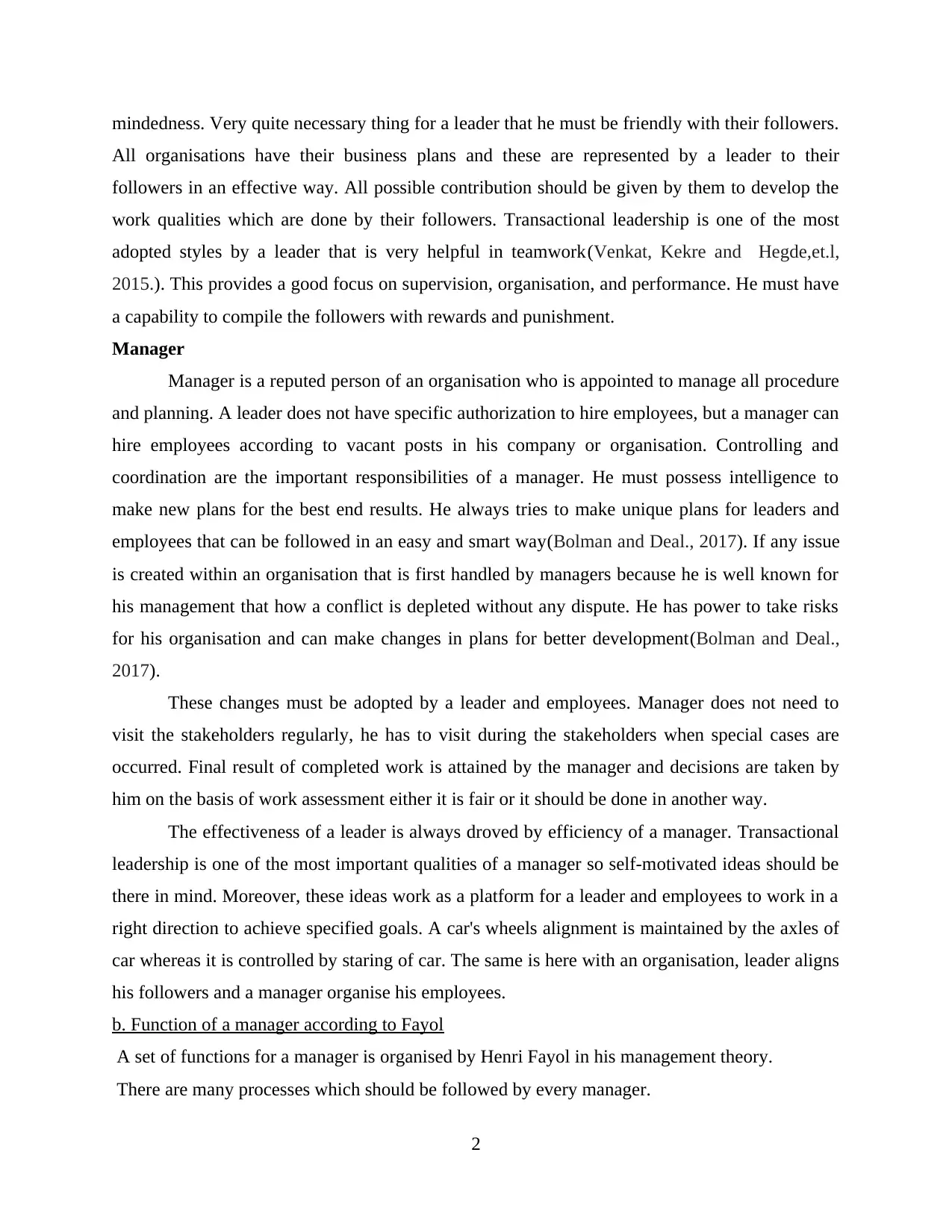
mindedness. Very quite necessary thing for a leader that he must be friendly with their followers.
All organisations have their business plans and these are represented by a leader to their
followers in an effective way. All possible contribution should be given by them to develop the
work qualities which are done by their followers. Transactional leadership is one of the most
adopted styles by a leader that is very helpful in teamwork(Venkat, Kekre and Hegde,et.l,
2015.). This provides a good focus on supervision, organisation, and performance. He must have
a capability to compile the followers with rewards and punishment.
Manager
Manager is a reputed person of an organisation who is appointed to manage all procedure
and planning. A leader does not have specific authorization to hire employees, but a manager can
hire employees according to vacant posts in his company or organisation. Controlling and
coordination are the important responsibilities of a manager. He must possess intelligence to
make new plans for the best end results. He always tries to make unique plans for leaders and
employees that can be followed in an easy and smart way(Bolman and Deal., 2017). If any issue
is created within an organisation that is first handled by managers because he is well known for
his management that how a conflict is depleted without any dispute. He has power to take risks
for his organisation and can make changes in plans for better development(Bolman and Deal.,
2017).
These changes must be adopted by a leader and employees. Manager does not need to
visit the stakeholders regularly, he has to visit during the stakeholders when special cases are
occurred. Final result of completed work is attained by the manager and decisions are taken by
him on the basis of work assessment either it is fair or it should be done in another way.
The effectiveness of a leader is always droved by efficiency of a manager. Transactional
leadership is one of the most important qualities of a manager so self-motivated ideas should be
there in mind. Moreover, these ideas work as a platform for a leader and employees to work in a
right direction to achieve specified goals. A car's wheels alignment is maintained by the axles of
car whereas it is controlled by staring of car. The same is here with an organisation, leader aligns
his followers and a manager organise his employees.
b. Function of a manager according to Fayol
A set of functions for a manager is organised by Henri Fayol in his management theory.
There are many processes which should be followed by every manager.
2
All organisations have their business plans and these are represented by a leader to their
followers in an effective way. All possible contribution should be given by them to develop the
work qualities which are done by their followers. Transactional leadership is one of the most
adopted styles by a leader that is very helpful in teamwork(Venkat, Kekre and Hegde,et.l,
2015.). This provides a good focus on supervision, organisation, and performance. He must have
a capability to compile the followers with rewards and punishment.
Manager
Manager is a reputed person of an organisation who is appointed to manage all procedure
and planning. A leader does not have specific authorization to hire employees, but a manager can
hire employees according to vacant posts in his company or organisation. Controlling and
coordination are the important responsibilities of a manager. He must possess intelligence to
make new plans for the best end results. He always tries to make unique plans for leaders and
employees that can be followed in an easy and smart way(Bolman and Deal., 2017). If any issue
is created within an organisation that is first handled by managers because he is well known for
his management that how a conflict is depleted without any dispute. He has power to take risks
for his organisation and can make changes in plans for better development(Bolman and Deal.,
2017).
These changes must be adopted by a leader and employees. Manager does not need to
visit the stakeholders regularly, he has to visit during the stakeholders when special cases are
occurred. Final result of completed work is attained by the manager and decisions are taken by
him on the basis of work assessment either it is fair or it should be done in another way.
The effectiveness of a leader is always droved by efficiency of a manager. Transactional
leadership is one of the most important qualities of a manager so self-motivated ideas should be
there in mind. Moreover, these ideas work as a platform for a leader and employees to work in a
right direction to achieve specified goals. A car's wheels alignment is maintained by the axles of
car whereas it is controlled by staring of car. The same is here with an organisation, leader aligns
his followers and a manager organise his employees.
b. Function of a manager according to Fayol
A set of functions for a manager is organised by Henri Fayol in his management theory.
There are many processes which should be followed by every manager.
2
Paraphrase This Document
Need a fresh take? Get an instant paraphrase of this document with our AI Paraphraser
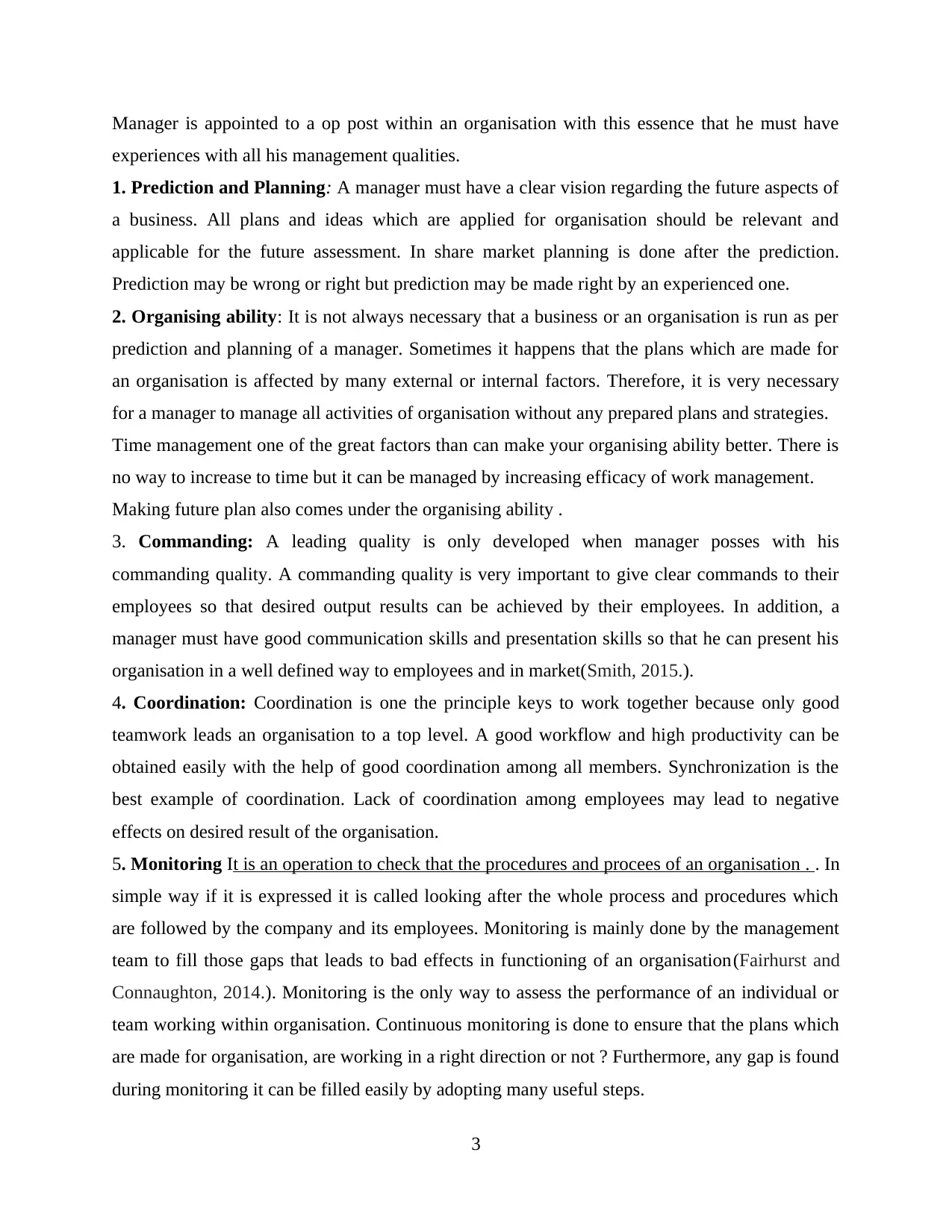
Manager is appointed to a op post within an organisation with this essence that he must have
experiences with all his management qualities.
1. Prediction and Planning: A manager must have a clear vision regarding the future aspects of
a business. All plans and ideas which are applied for organisation should be relevant and
applicable for the future assessment. In share market planning is done after the prediction.
Prediction may be wrong or right but prediction may be made right by an experienced one.
2. Organising ability: It is not always necessary that a business or an organisation is run as per
prediction and planning of a manager. Sometimes it happens that the plans which are made for
an organisation is affected by many external or internal factors. Therefore, it is very necessary
for a manager to manage all activities of organisation without any prepared plans and strategies.
Time management one of the great factors than can make your organising ability better. There is
no way to increase to time but it can be managed by increasing efficacy of work management.
Making future plan also comes under the organising ability .
3. Commanding: A leading quality is only developed when manager posses with his
commanding quality. A commanding quality is very important to give clear commands to their
employees so that desired output results can be achieved by their employees. In addition, a
manager must have good communication skills and presentation skills so that he can present his
organisation in a well defined way to employees and in market(Smith, 2015.).
4. Coordination: Coordination is one the principle keys to work together because only good
teamwork leads an organisation to a top level. A good workflow and high productivity can be
obtained easily with the help of good coordination among all members. Synchronization is the
best example of coordination. Lack of coordination among employees may lead to negative
effects on desired result of the organisation.
5. Monitoring It is an operation to check that the procedures and procees of an organisation . . In
simple way if it is expressed it is called looking after the whole process and procedures which
are followed by the company and its employees. Monitoring is mainly done by the management
team to fill those gaps that leads to bad effects in functioning of an organisation(Fairhurst and
Connaughton, 2014.). Monitoring is the only way to assess the performance of an individual or
team working within organisation. Continuous monitoring is done to ensure that the plans which
are made for organisation, are working in a right direction or not ? Furthermore, any gap is found
during monitoring it can be filled easily by adopting many useful steps.
3
experiences with all his management qualities.
1. Prediction and Planning: A manager must have a clear vision regarding the future aspects of
a business. All plans and ideas which are applied for organisation should be relevant and
applicable for the future assessment. In share market planning is done after the prediction.
Prediction may be wrong or right but prediction may be made right by an experienced one.
2. Organising ability: It is not always necessary that a business or an organisation is run as per
prediction and planning of a manager. Sometimes it happens that the plans which are made for
an organisation is affected by many external or internal factors. Therefore, it is very necessary
for a manager to manage all activities of organisation without any prepared plans and strategies.
Time management one of the great factors than can make your organising ability better. There is
no way to increase to time but it can be managed by increasing efficacy of work management.
Making future plan also comes under the organising ability .
3. Commanding: A leading quality is only developed when manager posses with his
commanding quality. A commanding quality is very important to give clear commands to their
employees so that desired output results can be achieved by their employees. In addition, a
manager must have good communication skills and presentation skills so that he can present his
organisation in a well defined way to employees and in market(Smith, 2015.).
4. Coordination: Coordination is one the principle keys to work together because only good
teamwork leads an organisation to a top level. A good workflow and high productivity can be
obtained easily with the help of good coordination among all members. Synchronization is the
best example of coordination. Lack of coordination among employees may lead to negative
effects on desired result of the organisation.
5. Monitoring It is an operation to check that the procedures and procees of an organisation . . In
simple way if it is expressed it is called looking after the whole process and procedures which
are followed by the company and its employees. Monitoring is mainly done by the management
team to fill those gaps that leads to bad effects in functioning of an organisation(Fairhurst and
Connaughton, 2014.). Monitoring is the only way to assess the performance of an individual or
team working within organisation. Continuous monitoring is done to ensure that the plans which
are made for organisation, are working in a right direction or not ? Furthermore, any gap is found
during monitoring it can be filled easily by adopting many useful steps.
3
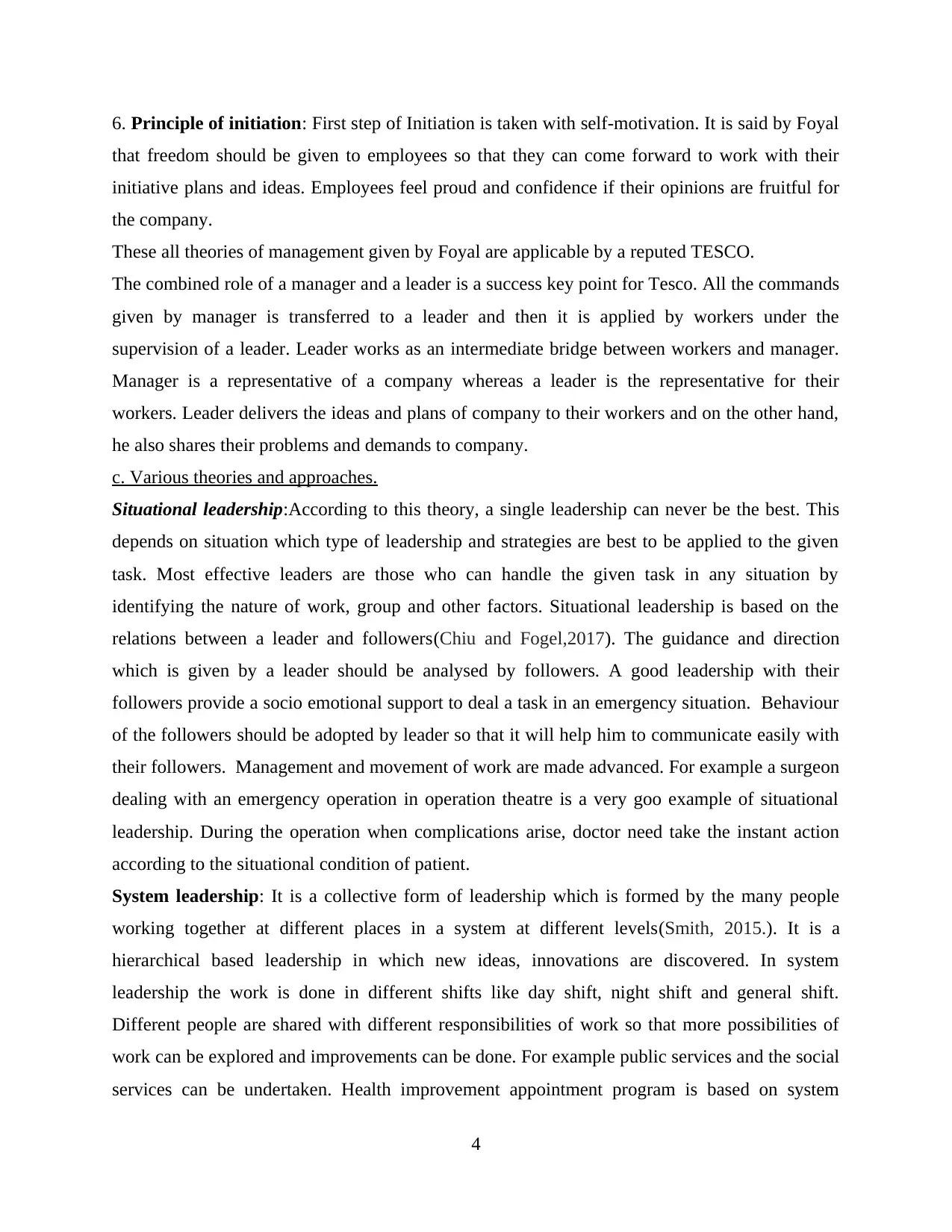
6. Principle of initiation: First step of Initiation is taken with self-motivation. It is said by Foyal
that freedom should be given to employees so that they can come forward to work with their
initiative plans and ideas. Employees feel proud and confidence if their opinions are fruitful for
the company.
These all theories of management given by Foyal are applicable by a reputed TESCO.
The combined role of a manager and a leader is a success key point for Tesco. All the commands
given by manager is transferred to a leader and then it is applied by workers under the
supervision of a leader. Leader works as an intermediate bridge between workers and manager.
Manager is a representative of a company whereas a leader is the representative for their
workers. Leader delivers the ideas and plans of company to their workers and on the other hand,
he also shares their problems and demands to company.
c. Various theories and approaches.
Situational leadership:According to this theory, a single leadership can never be the best. This
depends on situation which type of leadership and strategies are best to be applied to the given
task. Most effective leaders are those who can handle the given task in any situation by
identifying the nature of work, group and other factors. Situational leadership is based on the
relations between a leader and followers(Chiu and Fogel,2017). The guidance and direction
which is given by a leader should be analysed by followers. A good leadership with their
followers provide a socio emotional support to deal a task in an emergency situation. Behaviour
of the followers should be adopted by leader so that it will help him to communicate easily with
their followers. Management and movement of work are made advanced. For example a surgeon
dealing with an emergency operation in operation theatre is a very goo example of situational
leadership. During the operation when complications arise, doctor need take the instant action
according to the situational condition of patient.
System leadership: It is a collective form of leadership which is formed by the many people
working together at different places in a system at different levels(Smith, 2015.). It is a
hierarchical based leadership in which new ideas, innovations are discovered. In system
leadership the work is done in different shifts like day shift, night shift and general shift.
Different people are shared with different responsibilities of work so that more possibilities of
work can be explored and improvements can be done. For example public services and the social
services can be undertaken. Health improvement appointment program is based on system
4
that freedom should be given to employees so that they can come forward to work with their
initiative plans and ideas. Employees feel proud and confidence if their opinions are fruitful for
the company.
These all theories of management given by Foyal are applicable by a reputed TESCO.
The combined role of a manager and a leader is a success key point for Tesco. All the commands
given by manager is transferred to a leader and then it is applied by workers under the
supervision of a leader. Leader works as an intermediate bridge between workers and manager.
Manager is a representative of a company whereas a leader is the representative for their
workers. Leader delivers the ideas and plans of company to their workers and on the other hand,
he also shares their problems and demands to company.
c. Various theories and approaches.
Situational leadership:According to this theory, a single leadership can never be the best. This
depends on situation which type of leadership and strategies are best to be applied to the given
task. Most effective leaders are those who can handle the given task in any situation by
identifying the nature of work, group and other factors. Situational leadership is based on the
relations between a leader and followers(Chiu and Fogel,2017). The guidance and direction
which is given by a leader should be analysed by followers. A good leadership with their
followers provide a socio emotional support to deal a task in an emergency situation. Behaviour
of the followers should be adopted by leader so that it will help him to communicate easily with
their followers. Management and movement of work are made advanced. For example a surgeon
dealing with an emergency operation in operation theatre is a very goo example of situational
leadership. During the operation when complications arise, doctor need take the instant action
according to the situational condition of patient.
System leadership: It is a collective form of leadership which is formed by the many people
working together at different places in a system at different levels(Smith, 2015.). It is a
hierarchical based leadership in which new ideas, innovations are discovered. In system
leadership the work is done in different shifts like day shift, night shift and general shift.
Different people are shared with different responsibilities of work so that more possibilities of
work can be explored and improvements can be done. For example public services and the social
services can be undertaken. Health improvement appointment program is based on system
4
⊘ This is a preview!⊘
Do you want full access?
Subscribe today to unlock all pages.

Trusted by 1+ million students worldwide
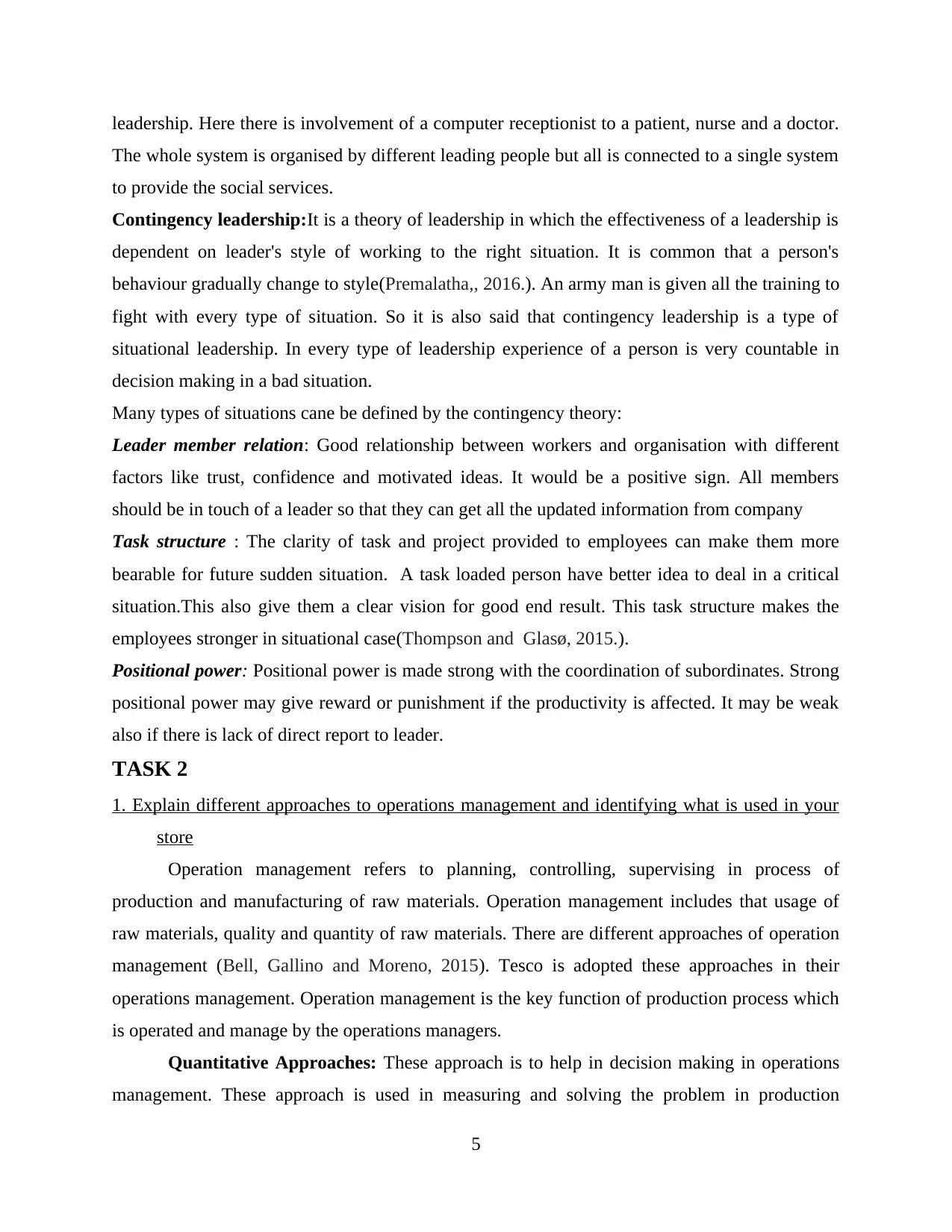
leadership. Here there is involvement of a computer receptionist to a patient, nurse and a doctor.
The whole system is organised by different leading people but all is connected to a single system
to provide the social services.
Contingency leadership:It is a theory of leadership in which the effectiveness of a leadership is
dependent on leader's style of working to the right situation. It is common that a person's
behaviour gradually change to style(Premalatha,, 2016.). An army man is given all the training to
fight with every type of situation. So it is also said that contingency leadership is a type of
situational leadership. In every type of leadership experience of a person is very countable in
decision making in a bad situation.
Many types of situations cane be defined by the contingency theory:
Leader member relation: Good relationship between workers and organisation with different
factors like trust, confidence and motivated ideas. It would be a positive sign. All members
should be in touch of a leader so that they can get all the updated information from company
Task structure : The clarity of task and project provided to employees can make them more
bearable for future sudden situation. A task loaded person have better idea to deal in a critical
situation.This also give them a clear vision for good end result. This task structure makes the
employees stronger in situational case(Thompson and Glasø, 2015.).
Positional power: Positional power is made strong with the coordination of subordinates. Strong
positional power may give reward or punishment if the productivity is affected. It may be weak
also if there is lack of direct report to leader.
TASK 2
1. Explain different approaches to operations management and identifying what is used in your
store
Operation management refers to planning, controlling, supervising in process of
production and manufacturing of raw materials. Operation management includes that usage of
raw materials, quality and quantity of raw materials. There are different approaches of operation
management (Bell, Gallino and Moreno, 2015). Tesco is adopted these approaches in their
operations management. Operation management is the key function of production process which
is operated and manage by the operations managers.
Quantitative Approaches: These approach is to help in decision making in operations
management. These approach is used in measuring and solving the problem in production
5
The whole system is organised by different leading people but all is connected to a single system
to provide the social services.
Contingency leadership:It is a theory of leadership in which the effectiveness of a leadership is
dependent on leader's style of working to the right situation. It is common that a person's
behaviour gradually change to style(Premalatha,, 2016.). An army man is given all the training to
fight with every type of situation. So it is also said that contingency leadership is a type of
situational leadership. In every type of leadership experience of a person is very countable in
decision making in a bad situation.
Many types of situations cane be defined by the contingency theory:
Leader member relation: Good relationship between workers and organisation with different
factors like trust, confidence and motivated ideas. It would be a positive sign. All members
should be in touch of a leader so that they can get all the updated information from company
Task structure : The clarity of task and project provided to employees can make them more
bearable for future sudden situation. A task loaded person have better idea to deal in a critical
situation.This also give them a clear vision for good end result. This task structure makes the
employees stronger in situational case(Thompson and Glasø, 2015.).
Positional power: Positional power is made strong with the coordination of subordinates. Strong
positional power may give reward or punishment if the productivity is affected. It may be weak
also if there is lack of direct report to leader.
TASK 2
1. Explain different approaches to operations management and identifying what is used in your
store
Operation management refers to planning, controlling, supervising in process of
production and manufacturing of raw materials. Operation management includes that usage of
raw materials, quality and quantity of raw materials. There are different approaches of operation
management (Bell, Gallino and Moreno, 2015). Tesco is adopted these approaches in their
operations management. Operation management is the key function of production process which
is operated and manage by the operations managers.
Quantitative Approaches: These approach is to help in decision making in operations
management. These approach is used in measuring and solving the problem in production
5
Paraphrase This Document
Need a fresh take? Get an instant paraphrase of this document with our AI Paraphraser
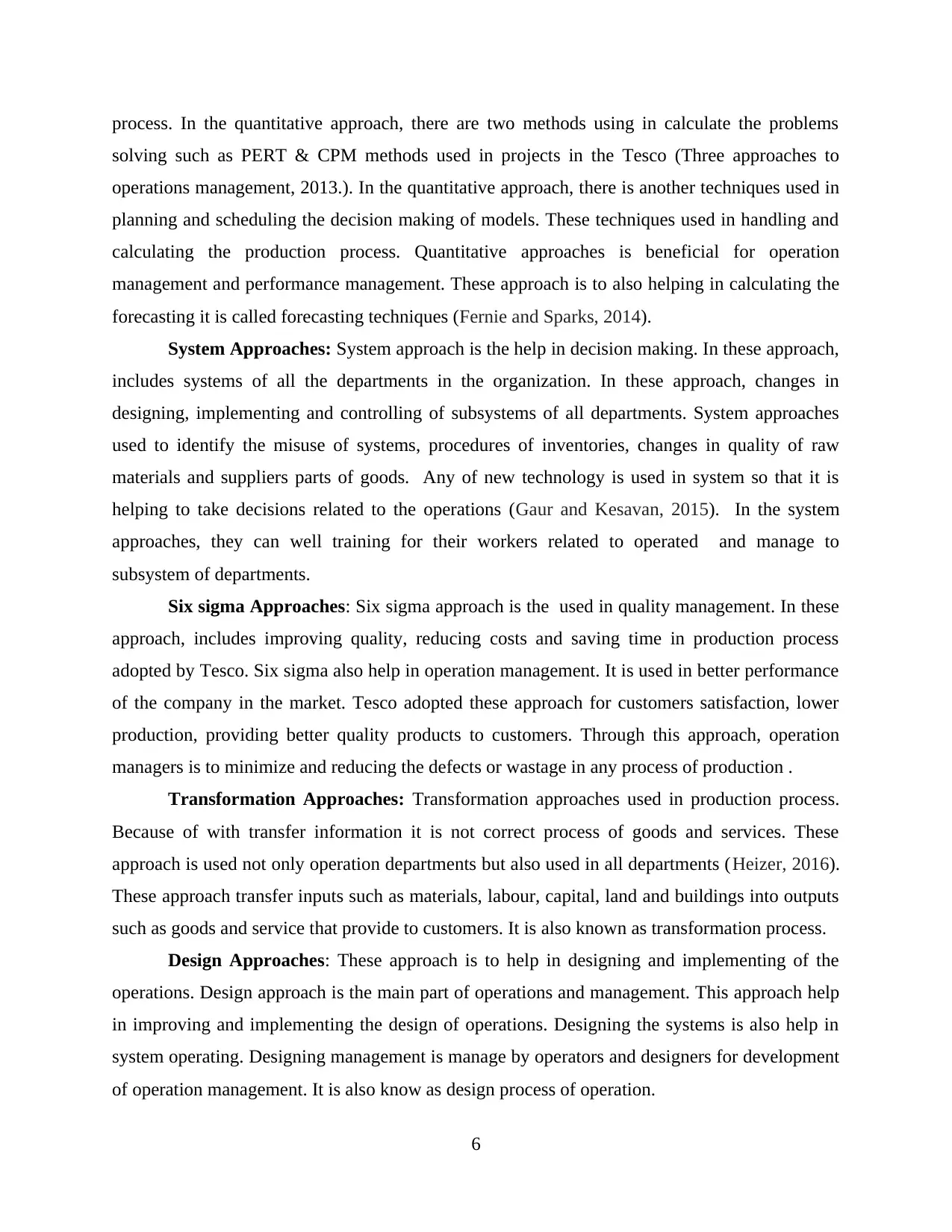
process. In the quantitative approach, there are two methods using in calculate the problems
solving such as PERT & CPM methods used in projects in the Tesco (Three approaches to
operations management, 2013.). In the quantitative approach, there is another techniques used in
planning and scheduling the decision making of models. These techniques used in handling and
calculating the production process. Quantitative approaches is beneficial for operation
management and performance management. These approach is to also helping in calculating the
forecasting it is called forecasting techniques (Fernie and Sparks, 2014).
System Approaches: System approach is the help in decision making. In these approach,
includes systems of all the departments in the organization. In these approach, changes in
designing, implementing and controlling of subsystems of all departments. System approaches
used to identify the misuse of systems, procedures of inventories, changes in quality of raw
materials and suppliers parts of goods. Any of new technology is used in system so that it is
helping to take decisions related to the operations (Gaur and Kesavan, 2015). In the system
approaches, they can well training for their workers related to operated and manage to
subsystem of departments.
Six sigma Approaches: Six sigma approach is the used in quality management. In these
approach, includes improving quality, reducing costs and saving time in production process
adopted by Tesco. Six sigma also help in operation management. It is used in better performance
of the company in the market. Tesco adopted these approach for customers satisfaction, lower
production, providing better quality products to customers. Through this approach, operation
managers is to minimize and reducing the defects or wastage in any process of production .
Transformation Approaches: Transformation approaches used in production process.
Because of with transfer information it is not correct process of goods and services. These
approach is used not only operation departments but also used in all departments (Heizer, 2016).
These approach transfer inputs such as materials, labour, capital, land and buildings into outputs
such as goods and service that provide to customers. It is also known as transformation process.
Design Approaches: These approach is to help in designing and implementing of the
operations. Design approach is the main part of operations and management. This approach help
in improving and implementing the design of operations. Designing the systems is also help in
system operating. Designing management is manage by operators and designers for development
of operation management. It is also know as design process of operation.
6
solving such as PERT & CPM methods used in projects in the Tesco (Three approaches to
operations management, 2013.). In the quantitative approach, there is another techniques used in
planning and scheduling the decision making of models. These techniques used in handling and
calculating the production process. Quantitative approaches is beneficial for operation
management and performance management. These approach is to also helping in calculating the
forecasting it is called forecasting techniques (Fernie and Sparks, 2014).
System Approaches: System approach is the help in decision making. In these approach,
includes systems of all the departments in the organization. In these approach, changes in
designing, implementing and controlling of subsystems of all departments. System approaches
used to identify the misuse of systems, procedures of inventories, changes in quality of raw
materials and suppliers parts of goods. Any of new technology is used in system so that it is
helping to take decisions related to the operations (Gaur and Kesavan, 2015). In the system
approaches, they can well training for their workers related to operated and manage to
subsystem of departments.
Six sigma Approaches: Six sigma approach is the used in quality management. In these
approach, includes improving quality, reducing costs and saving time in production process
adopted by Tesco. Six sigma also help in operation management. It is used in better performance
of the company in the market. Tesco adopted these approach for customers satisfaction, lower
production, providing better quality products to customers. Through this approach, operation
managers is to minimize and reducing the defects or wastage in any process of production .
Transformation Approaches: Transformation approaches used in production process.
Because of with transfer information it is not correct process of goods and services. These
approach is used not only operation departments but also used in all departments (Heizer, 2016).
These approach transfer inputs such as materials, labour, capital, land and buildings into outputs
such as goods and service that provide to customers. It is also known as transformation process.
Design Approaches: These approach is to help in designing and implementing of the
operations. Design approach is the main part of operations and management. This approach help
in improving and implementing the design of operations. Designing the systems is also help in
system operating. Designing management is manage by operators and designers for development
of operation management. It is also know as design process of operation.
6
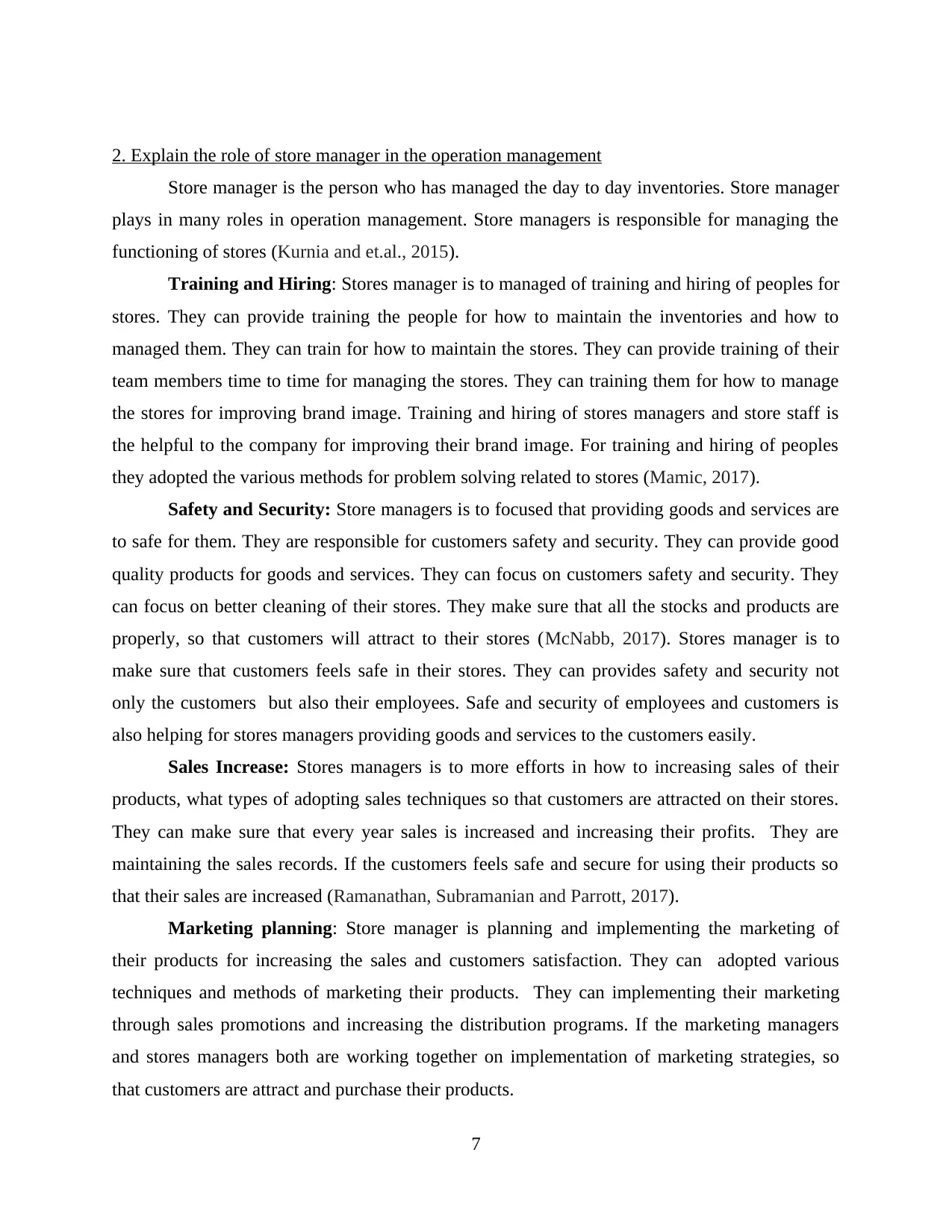
2. Explain the role of store manager in the operation management
Store manager is the person who has managed the day to day inventories. Store manager
plays in many roles in operation management. Store managers is responsible for managing the
functioning of stores (Kurnia and et.al., 2015).
Training and Hiring: Stores manager is to managed of training and hiring of peoples for
stores. They can provide training the people for how to maintain the inventories and how to
managed them. They can train for how to maintain the stores. They can provide training of their
team members time to time for managing the stores. They can training them for how to manage
the stores for improving brand image. Training and hiring of stores managers and store staff is
the helpful to the company for improving their brand image. For training and hiring of peoples
they adopted the various methods for problem solving related to stores (Mamic, 2017).
Safety and Security: Store managers is to focused that providing goods and services are
to safe for them. They are responsible for customers safety and security. They can provide good
quality products for goods and services. They can focus on customers safety and security. They
can focus on better cleaning of their stores. They make sure that all the stocks and products are
properly, so that customers will attract to their stores (McNabb, 2017). Stores manager is to
make sure that customers feels safe in their stores. They can provides safety and security not
only the customers but also their employees. Safe and security of employees and customers is
also helping for stores managers providing goods and services to the customers easily.
Sales Increase: Stores managers is to more efforts in how to increasing sales of their
products, what types of adopting sales techniques so that customers are attracted on their stores.
They can make sure that every year sales is increased and increasing their profits. They are
maintaining the sales records. If the customers feels safe and secure for using their products so
that their sales are increased (Ramanathan, Subramanian and Parrott, 2017).
Marketing planning: Store manager is planning and implementing the marketing of
their products for increasing the sales and customers satisfaction. They can adopted various
techniques and methods of marketing their products. They can implementing their marketing
through sales promotions and increasing the distribution programs. If the marketing managers
and stores managers both are working together on implementation of marketing strategies, so
that customers are attract and purchase their products.
7
Store manager is the person who has managed the day to day inventories. Store manager
plays in many roles in operation management. Store managers is responsible for managing the
functioning of stores (Kurnia and et.al., 2015).
Training and Hiring: Stores manager is to managed of training and hiring of peoples for
stores. They can provide training the people for how to maintain the inventories and how to
managed them. They can train for how to maintain the stores. They can provide training of their
team members time to time for managing the stores. They can training them for how to manage
the stores for improving brand image. Training and hiring of stores managers and store staff is
the helpful to the company for improving their brand image. For training and hiring of peoples
they adopted the various methods for problem solving related to stores (Mamic, 2017).
Safety and Security: Store managers is to focused that providing goods and services are
to safe for them. They are responsible for customers safety and security. They can provide good
quality products for goods and services. They can focus on customers safety and security. They
can focus on better cleaning of their stores. They make sure that all the stocks and products are
properly, so that customers will attract to their stores (McNabb, 2017). Stores manager is to
make sure that customers feels safe in their stores. They can provides safety and security not
only the customers but also their employees. Safe and security of employees and customers is
also helping for stores managers providing goods and services to the customers easily.
Sales Increase: Stores managers is to more efforts in how to increasing sales of their
products, what types of adopting sales techniques so that customers are attracted on their stores.
They can make sure that every year sales is increased and increasing their profits. They are
maintaining the sales records. If the customers feels safe and secure for using their products so
that their sales are increased (Ramanathan, Subramanian and Parrott, 2017).
Marketing planning: Store manager is planning and implementing the marketing of
their products for increasing the sales and customers satisfaction. They can adopted various
techniques and methods of marketing their products. They can implementing their marketing
through sales promotions and increasing the distribution programs. If the marketing managers
and stores managers both are working together on implementation of marketing strategies, so
that customers are attract and purchase their products.
7
⊘ This is a preview!⊘
Do you want full access?
Subscribe today to unlock all pages.

Trusted by 1+ million students worldwide
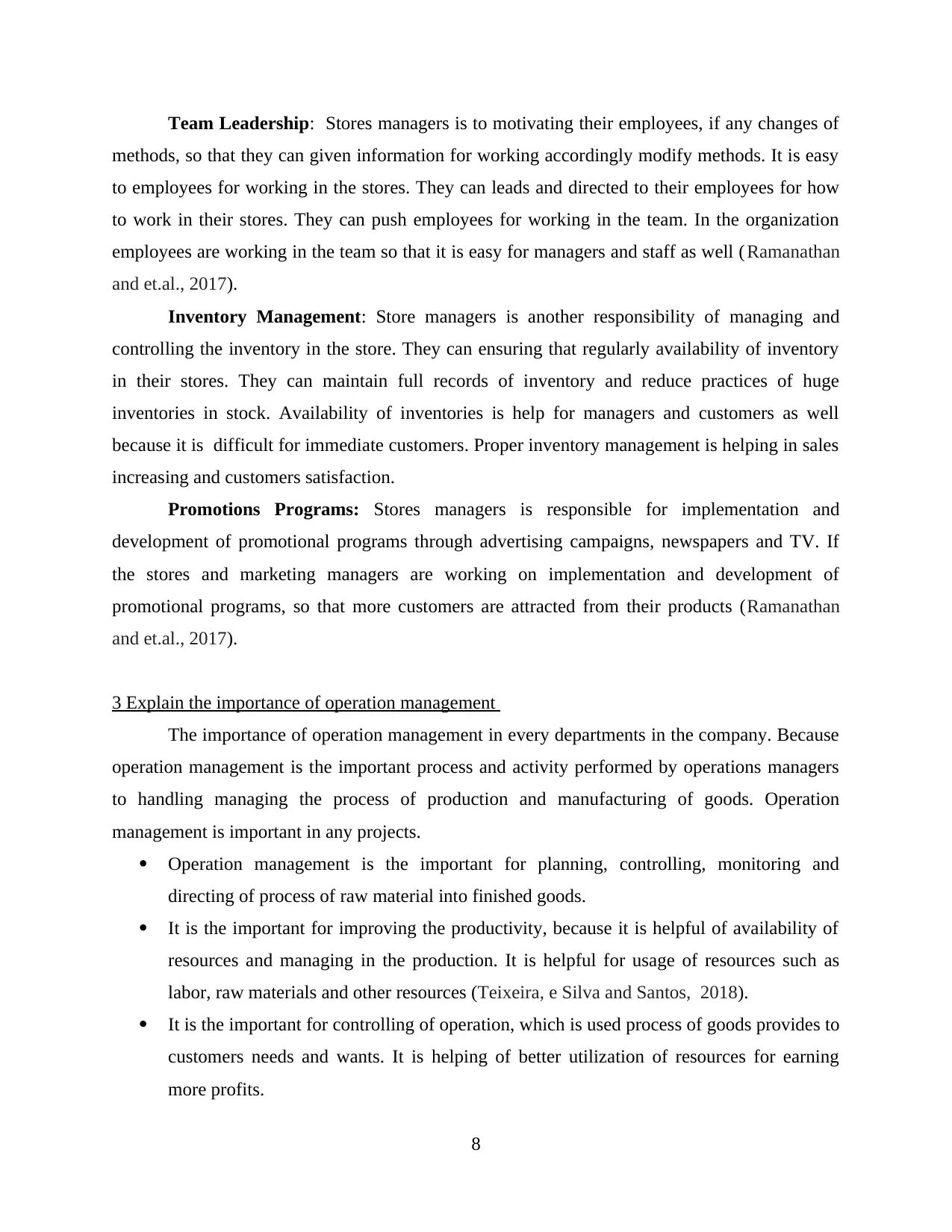
Team Leadership: Stores managers is to motivating their employees, if any changes of
methods, so that they can given information for working accordingly modify methods. It is easy
to employees for working in the stores. They can leads and directed to their employees for how
to work in their stores. They can push employees for working in the team. In the organization
employees are working in the team so that it is easy for managers and staff as well ( Ramanathan
and et.al., 2017).
Inventory Management: Store managers is another responsibility of managing and
controlling the inventory in the store. They can ensuring that regularly availability of inventory
in their stores. They can maintain full records of inventory and reduce practices of huge
inventories in stock. Availability of inventories is help for managers and customers as well
because it is difficult for immediate customers. Proper inventory management is helping in sales
increasing and customers satisfaction.
Promotions Programs: Stores managers is responsible for implementation and
development of promotional programs through advertising campaigns, newspapers and TV. If
the stores and marketing managers are working on implementation and development of
promotional programs, so that more customers are attracted from their products (Ramanathan
and et.al., 2017).
3 Explain the importance of operation management
The importance of operation management in every departments in the company. Because
operation management is the important process and activity performed by operations managers
to handling managing the process of production and manufacturing of goods. Operation
management is important in any projects.
Operation management is the important for planning, controlling, monitoring and
directing of process of raw material into finished goods.
It is the important for improving the productivity, because it is helpful of availability of
resources and managing in the production. It is helpful for usage of resources such as
labor, raw materials and other resources (Teixeira, e Silva and Santos, 2018).
It is the important for controlling of operation, which is used process of goods provides to
customers needs and wants. It is helping of better utilization of resources for earning
more profits.
8
methods, so that they can given information for working accordingly modify methods. It is easy
to employees for working in the stores. They can leads and directed to their employees for how
to work in their stores. They can push employees for working in the team. In the organization
employees are working in the team so that it is easy for managers and staff as well ( Ramanathan
and et.al., 2017).
Inventory Management: Store managers is another responsibility of managing and
controlling the inventory in the store. They can ensuring that regularly availability of inventory
in their stores. They can maintain full records of inventory and reduce practices of huge
inventories in stock. Availability of inventories is help for managers and customers as well
because it is difficult for immediate customers. Proper inventory management is helping in sales
increasing and customers satisfaction.
Promotions Programs: Stores managers is responsible for implementation and
development of promotional programs through advertising campaigns, newspapers and TV. If
the stores and marketing managers are working on implementation and development of
promotional programs, so that more customers are attracted from their products (Ramanathan
and et.al., 2017).
3 Explain the importance of operation management
The importance of operation management in every departments in the company. Because
operation management is the important process and activity performed by operations managers
to handling managing the process of production and manufacturing of goods. Operation
management is important in any projects.
Operation management is the important for planning, controlling, monitoring and
directing of process of raw material into finished goods.
It is the important for improving the productivity, because it is helpful of availability of
resources and managing in the production. It is helpful for usage of resources such as
labor, raw materials and other resources (Teixeira, e Silva and Santos, 2018).
It is the important for controlling of operation, which is used process of goods provides to
customers needs and wants. It is helping of better utilization of resources for earning
more profits.
8
Paraphrase This Document
Need a fresh take? Get an instant paraphrase of this document with our AI Paraphraser
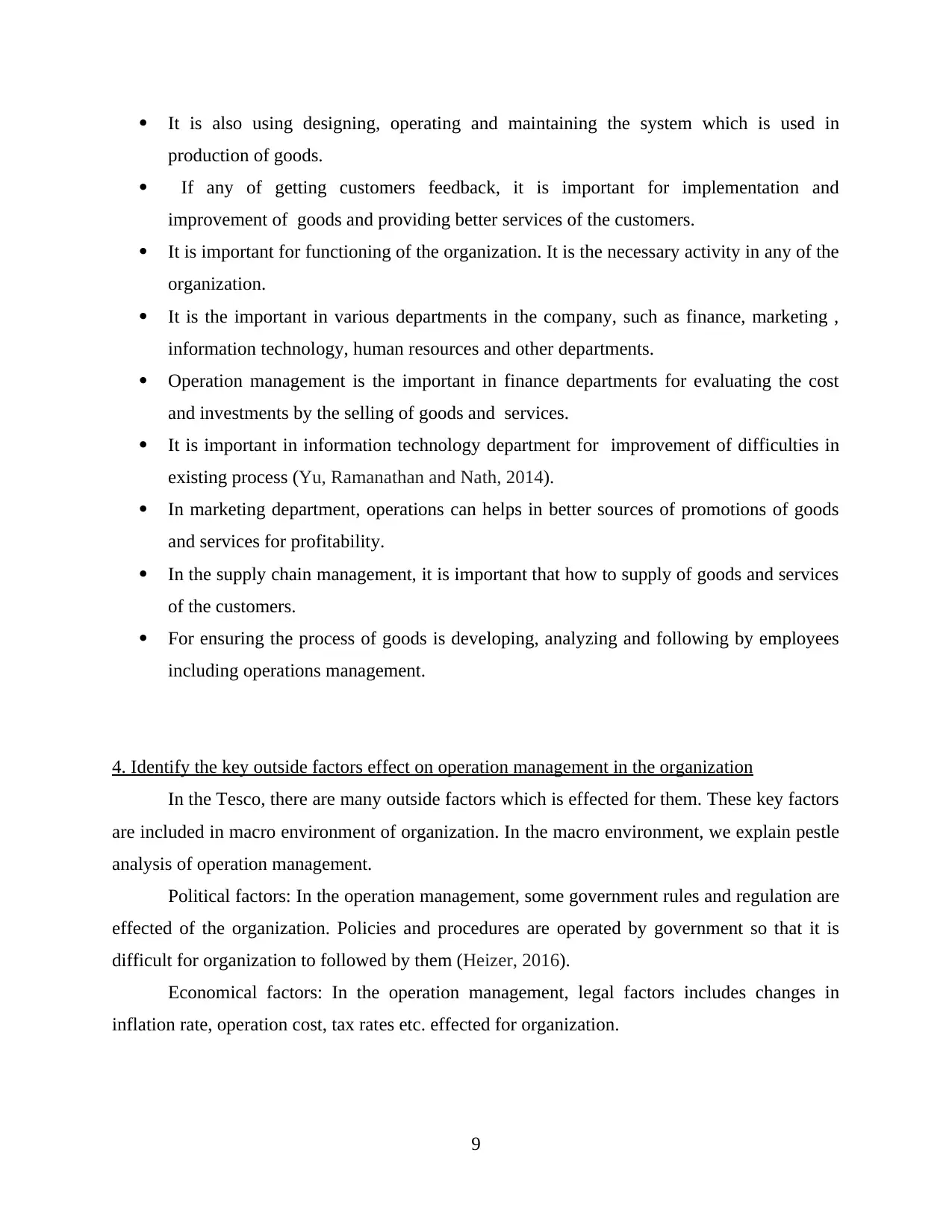
It is also using designing, operating and maintaining the system which is used in
production of goods.
If any of getting customers feedback, it is important for implementation and
improvement of goods and providing better services of the customers.
It is important for functioning of the organization. It is the necessary activity in any of the
organization.
It is the important in various departments in the company, such as finance, marketing ,
information technology, human resources and other departments.
Operation management is the important in finance departments for evaluating the cost
and investments by the selling of goods and services.
It is important in information technology department for improvement of difficulties in
existing process (Yu, Ramanathan and Nath, 2014).
In marketing department, operations can helps in better sources of promotions of goods
and services for profitability.
In the supply chain management, it is important that how to supply of goods and services
of the customers.
For ensuring the process of goods is developing, analyzing and following by employees
including operations management.
4. Identify the key outside factors effect on operation management in the organization
In the Tesco, there are many outside factors which is effected for them. These key factors
are included in macro environment of organization. In the macro environment, we explain pestle
analysis of operation management.
Political factors: In the operation management, some government rules and regulation are
effected of the organization. Policies and procedures are operated by government so that it is
difficult for organization to followed by them (Heizer, 2016).
Economical factors: In the operation management, legal factors includes changes in
inflation rate, operation cost, tax rates etc. effected for organization.
9
production of goods.
If any of getting customers feedback, it is important for implementation and
improvement of goods and providing better services of the customers.
It is important for functioning of the organization. It is the necessary activity in any of the
organization.
It is the important in various departments in the company, such as finance, marketing ,
information technology, human resources and other departments.
Operation management is the important in finance departments for evaluating the cost
and investments by the selling of goods and services.
It is important in information technology department for improvement of difficulties in
existing process (Yu, Ramanathan and Nath, 2014).
In marketing department, operations can helps in better sources of promotions of goods
and services for profitability.
In the supply chain management, it is important that how to supply of goods and services
of the customers.
For ensuring the process of goods is developing, analyzing and following by employees
including operations management.
4. Identify the key outside factors effect on operation management in the organization
In the Tesco, there are many outside factors which is effected for them. These key factors
are included in macro environment of organization. In the macro environment, we explain pestle
analysis of operation management.
Political factors: In the operation management, some government rules and regulation are
effected of the organization. Policies and procedures are operated by government so that it is
difficult for organization to followed by them (Heizer, 2016).
Economical factors: In the operation management, legal factors includes changes in
inflation rate, operation cost, tax rates etc. effected for organization.
9
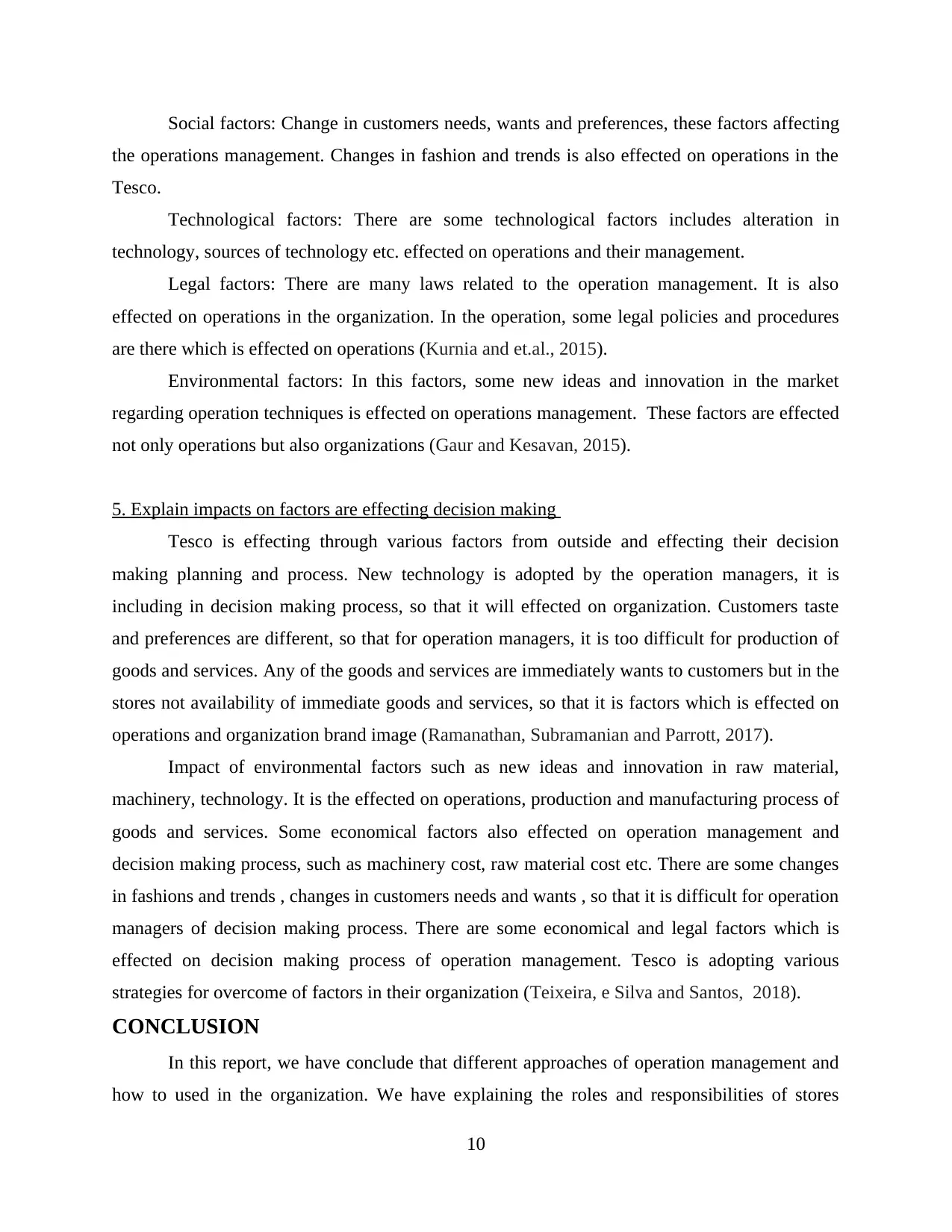
Social factors: Change in customers needs, wants and preferences, these factors affecting
the operations management. Changes in fashion and trends is also effected on operations in the
Tesco.
Technological factors: There are some technological factors includes alteration in
technology, sources of technology etc. effected on operations and their management.
Legal factors: There are many laws related to the operation management. It is also
effected on operations in the organization. In the operation, some legal policies and procedures
are there which is effected on operations (Kurnia and et.al., 2015).
Environmental factors: In this factors, some new ideas and innovation in the market
regarding operation techniques is effected on operations management. These factors are effected
not only operations but also organizations (Gaur and Kesavan, 2015).
5. Explain impacts on factors are effecting decision making
Tesco is effecting through various factors from outside and effecting their decision
making planning and process. New technology is adopted by the operation managers, it is
including in decision making process, so that it will effected on organization. Customers taste
and preferences are different, so that for operation managers, it is too difficult for production of
goods and services. Any of the goods and services are immediately wants to customers but in the
stores not availability of immediate goods and services, so that it is factors which is effected on
operations and organization brand image (Ramanathan, Subramanian and Parrott, 2017).
Impact of environmental factors such as new ideas and innovation in raw material,
machinery, technology. It is the effected on operations, production and manufacturing process of
goods and services. Some economical factors also effected on operation management and
decision making process, such as machinery cost, raw material cost etc. There are some changes
in fashions and trends , changes in customers needs and wants , so that it is difficult for operation
managers of decision making process. There are some economical and legal factors which is
effected on decision making process of operation management. Tesco is adopting various
strategies for overcome of factors in their organization (Teixeira, e Silva and Santos, 2018).
CONCLUSION
In this report, we have conclude that different approaches of operation management and
how to used in the organization. We have explaining the roles and responsibilities of stores
10
the operations management. Changes in fashion and trends is also effected on operations in the
Tesco.
Technological factors: There are some technological factors includes alteration in
technology, sources of technology etc. effected on operations and their management.
Legal factors: There are many laws related to the operation management. It is also
effected on operations in the organization. In the operation, some legal policies and procedures
are there which is effected on operations (Kurnia and et.al., 2015).
Environmental factors: In this factors, some new ideas and innovation in the market
regarding operation techniques is effected on operations management. These factors are effected
not only operations but also organizations (Gaur and Kesavan, 2015).
5. Explain impacts on factors are effecting decision making
Tesco is effecting through various factors from outside and effecting their decision
making planning and process. New technology is adopted by the operation managers, it is
including in decision making process, so that it will effected on organization. Customers taste
and preferences are different, so that for operation managers, it is too difficult for production of
goods and services. Any of the goods and services are immediately wants to customers but in the
stores not availability of immediate goods and services, so that it is factors which is effected on
operations and organization brand image (Ramanathan, Subramanian and Parrott, 2017).
Impact of environmental factors such as new ideas and innovation in raw material,
machinery, technology. It is the effected on operations, production and manufacturing process of
goods and services. Some economical factors also effected on operation management and
decision making process, such as machinery cost, raw material cost etc. There are some changes
in fashions and trends , changes in customers needs and wants , so that it is difficult for operation
managers of decision making process. There are some economical and legal factors which is
effected on decision making process of operation management. Tesco is adopting various
strategies for overcome of factors in their organization (Teixeira, e Silva and Santos, 2018).
CONCLUSION
In this report, we have conclude that different approaches of operation management and
how to used in the organization. We have explaining the roles and responsibilities of stores
10
⊘ This is a preview!⊘
Do you want full access?
Subscribe today to unlock all pages.

Trusted by 1+ million students worldwide
1 out of 15
Related Documents
Your All-in-One AI-Powered Toolkit for Academic Success.
+13062052269
info@desklib.com
Available 24*7 on WhatsApp / Email
![[object Object]](/_next/static/media/star-bottom.7253800d.svg)
Unlock your academic potential
Copyright © 2020–2025 A2Z Services. All Rights Reserved. Developed and managed by ZUCOL.





